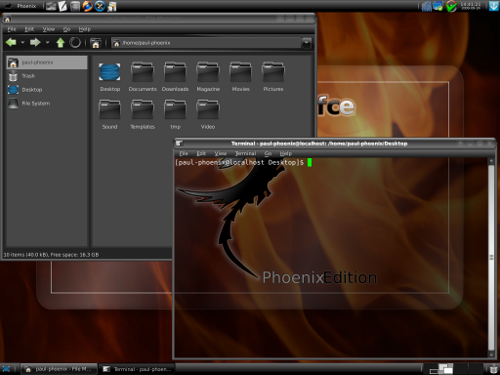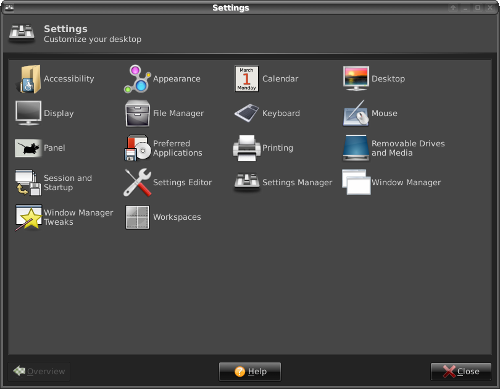Phoenix 2009.4 Final Released
by Paul Arnote (parnote)

Phoenix, the PCLinuxOS XFCE remaster, was released on September 14, 2009, by Sproggy, who made and packaged the remaster as part of a community project on MyPCLinuxOS.com. And this is not your normal XFCE release, that looks like Windows 98. This XFCE remaster is attractive, styled in a classy, dark theme. Although the XFCE desktop environment is a light weight desktop, Phoenix is a heavy weight contender. Phoenix utilizes the latest stable version of XFCE, with version 4.6.1, and runs the latest stable kernel, 2.6.26.8.tex3.
As with all the versions of PCLinuxOS, you will find familiarity with the presence of the PCLinuxOS Control Center and Synaptic. Also installed, by default, is the Firefox 3.5 web browser, and Thunderbird is available for your email duties.
GIMP takes care of most of your graphics needs, and there is a screen shot utility. Image Viewer provides a fast, easy way to quickly view graphics on your system.
Sound file playback is handled by Listen Music Player, and I was quite pleasantly surprised by the capabilities of this player that I had never tried. There is the Sound Recorder application, as well. A sound mixer application gives you full access to your sound card settings, while Totem Movie Player takes care of your video playback needs.
File manager duties are handled by Thunar. Navigation is easy, and Thunar has all the functionality one could hope for in a file manager. Thunar is designed to have a small memory footprint, and is extensible through plug-ins.
Mousepad, the default text editor for XFCE, is present to handle your text editing needs. Orage, an enhanced calendar program for XFCE, is also present, handling your calendar reminders. Orage has user-defined alarms, and even incorporates a to-do list to help keep you organized.

XFCE uses the same GTK+ 2 toolkit used by Gnome, and users familiar with Gnome will find themselves right at home. The XFWM window manager is used, however, in place of the full Gnome window manager. Yet, KDE users will have little difficulty in making themselves right at home.
Similar to the KDE Control Center, all the settings for the XFCE desktop environment are handled by the XFCE Settings Manager.
You can, of course, add most any of the programs from the PCLinuxOS repository, using Synaptic. OpenOffice installs easily via the GetOpenOffice utility (in the Utilities folder on the desktop), and runs effortlessly.
On my computer that I have set up as a test box (AMD Athlon XP 3000+, 1.5 GB Memory, NVidia FX 5200 video card), Phoenix runs fast and smooth. But the real treat comes in running the XFCE desktop environment on older, more modest hardware. Installed on my seven year old IBM Thinkpad T23 (Pentium III, 1130 MHz, 512 MB RAM), Phoenix is fast and responsive, breathing new life into this older laptop of mine. Phoenix is capable of running on a Pentium II with as little as 128 MB of memory, although performance will be improved with more memory and a faster processor.
So Why "Phoenix?"
From the website:
"The Phoenix is a mythical bird with a colourful plumage and a tail of gold and scarlet (or purple, blue, and green according to some legends). It has a 500 to 1,000 year life-cycle, near the end of which it builds itself a nest of myrrh twigs that then ignites; both nest and bird burn fiercely and are reduced to ashes, from which a new, young Phoenix or Phoenix egg arises, reborn anew to live again. The new Phoenix is destined to live as long as its old self. In some stories, the new Phoenix embalms the ashes of its old self in an egg made of myrrh and deposits it in the Egyptian city of Heliopolis (sun city in Greek).
Our Phoenix, like that throughout history, is here to live as long a life as it’s predecessor. She will flourish and grow and create anew for all her users in the future."
So, just as the mythical Phoenix rose from the ashes, so has PCLinuxOS Phoenix 2009.4 risen from the ashes to become the official PCLinuxOS XFCE offering.
Summary
Phoenix presents users another choice for a fast, light weight desktop, joining PCLXDE as a choice for a version of PCLinuxOS that will run on more modest hardware. It's lean, and it's fast, but it also has all the muscle and stability you have come to expect from PCLinuxOS and Texstar. Sproggy has continued that reputation with this release of Phoenix - the PCLinuxOS XFCE Remaster.